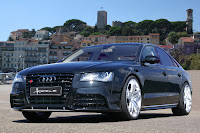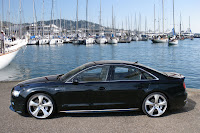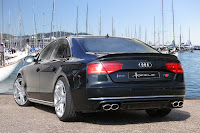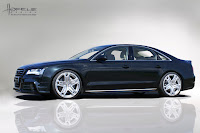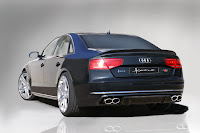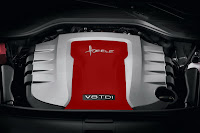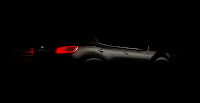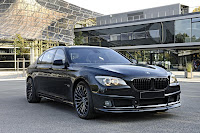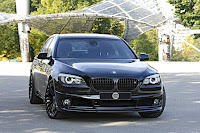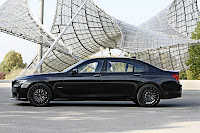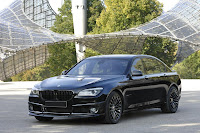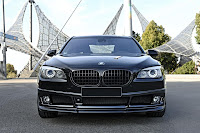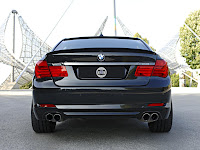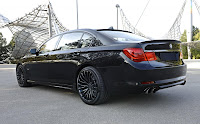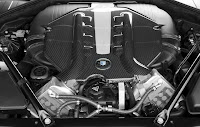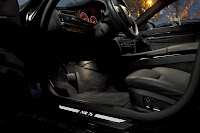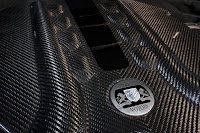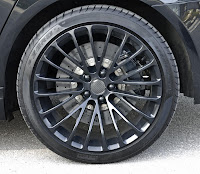BMW has unveiled the new 2012 3-Series,which will debut at U.S. dealers, with all-wheel-drive and hybrid versions slated to arrive later in 2012.
The six-cylinder engine featuring in the 2012 BMW 3-Series is BMW’s venerable 3.0-liter ‘N55’ unit and in this latest application develops 300 horsepower and 300 pound-feet of torque, the latter coming on from just 1,200 rpm and staying all the way to 5,000.
Standard equipment includes air-conditioning, Bluetooth, a 6.5-inch colour screen with iDrive, keyless starting, USB, multi-function steering wheel, cruise control, power windows and locks. A full-colour Head-Up display, as well as a host of other safety features such as lane-change warning will be available.
Inside, the black trim is continued and accented with red. Two upholstery styles and three colors are available for the standard sport seats, and the ignition fob is black with red details. Unique 18-inch dual-spoke alloy wheels finish the look.
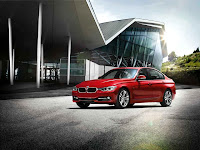



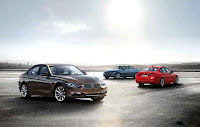

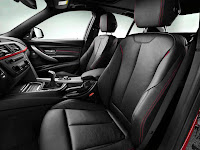
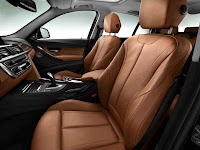
Press Release
1. The new BMW 3 Series Sedan: Dynamic capability, efficiency and comfort are given the perfect stage.
- New BMW face emphasises dynamic and elegant design.
- BMW 3 Series now available in three different equipment lines.
- Full-colour Head-Up Display for the sports sedan.
- Sporty suspension tuning with enhanced ride comfort.
- All engines with the latest BMW TwinPower Turbo technology.
- All engines can be combined with an eight-speed automatic gearbox.
- Driving Experience Control with Eco Pro mode; Auto Start-Stop function included
- as standard.
The sixth generation of the BMW 3 Series Sedan, the world’s best-selling
premium car, sets new benchmarks in terms of sporting prowess, elegance and
comfort. The pioneering history of the 3 Series serves as inspiration for the new
sports sedan, whose powerful styling represents a fresh interpretation and
conscientious development of traditional BMW design cues. The new BMW
face, with flat headlights reaching along as far as the BMW kidney grille,
emphasises the elegantly dynamic design of the new BMW 3 Series. The sixth
generation of the 3 Series has grown in size compared to its predecessor, with
its wide track (front + 37 mm, rear + 47 mm) particularly prominent, and the car’s
increased length (+ 93 mm) and augmented wheelbase (+ 50 mm) also
accentuate its sporting silhouette. Inside the new BMW 3 Series Sedan, the
noticeable increase in space benefits the rear passengers above all. And the
BMW 3 Series range is now also available in a trio of trim and equipment
variants – the Sport Line, Luxury Line and Modern Line. Each presents its own
individual take on the character of the sports sedan, with exclusive, high-quality
material combinations and unbeatable build quality underlining the premium
ambience of the new range.
Drive and chassis technology have always been key areas of expertise for the brand,
and agility and driving dynamics remain outstanding attributes of the new
BMW 3 Series Sedan. The new car belies its larger dimensions with a kerb weight
40 kilograms (88 lb) below that of its predecessor. In addition to the sports
performance typical of the brand, the further enhanced levels of comfort on board the
new 3 Series make a significant contribution to driving pleasure.
A choice of four refined, economical and muscular engines – all of which feature
new BMW TwinPower Turbo technology – will be available for the new BMW 3 Series Sedan from launch. In addition to two further optimised diesel
powerplants and the already successful six-cylinder petrol unit, customers can
also enjoy the talents of the new turbocharged four-cylinder variant in the
BMW 328i. This latest-generation petrol engine rewards the driver with a
dynamic driving experience coupled with reduced fuel consumption and
emissions.
BMW is the first carmaker to offer an eight-speed automatic gearbox in the
premium mid-size segment. It can be specified in combination with any of the
petrol and diesel engines in the range and links up with the Auto Start-Stop
function that comes as standard. Compact and exceptionally efficient, it allows
the new BMW 3 Series to match or outperform models fitted with the standard
six-speed manual gearbox in terms of both fuel economy and emissions. The
new eight-speed automatic brings together shift comfort, dynamic performance
and efficiency of the highest order, making it the perfect partner for the new
sedan’s dynamic potential.
As components of the BMW EfficientDynamics technology line-up, the
Auto Start-Stop function, Brake Energy Regeneration, Optimum Shift Indicator
and need-based operation of ancillary components (including a disengageable
air conditioning compressor) also play their part in reducing fuel consumption.
Added to which, the new Driving Experience Control switch not only offers
Comfort, Sport and Sport + options, but also ECO PRO mode, which gives all
the models in the range the potential to further improve these figures. This
switch helps drivers maximise fuel economy through their driving style, thereby
enabling them to increase the distance they can travel between visits to the
pumps. The same goes for the CO2-minimising BMW 320d EfficientDynamics
Edition, whose peak output of 120 kW/163 hp contrasts with average fuel
consumption in the EU driving cycle of 4.1 l/100 km (68.9 mpg imp) and
CO2 emissions of 109 g/km. BMW will add further cutting-edge engines to the
line-up in 2012, when the BMW ActiveHybrid 3 will also celebrate its premiere.
Enhanced superiority, convenience and safety thanks to intelligent connectivity.
BMW ConnectedDrive offers an unmatched combination of driver assistance
technology and mobility systems for the new BMW 3 Series range. A new arrival
in the premium mid-size segment is the latest-generation full-colour
Head-Up Display, which projects key information – in sharp resolution – onto the
windscreen so it appears directly in the driver’s field of view. Also available is
Surround View with Side View and Top View, which gives a bird’s-eye
perspective of the vehicle and the area around it. In addition, a parking
assistance system helps the driver to manoeuvre into parking spaces. Among
the other assistance technology available under the BMW ConnectedDrive
banner are Active Cruise Control with Stop&Go function, the Lane Change
Warning System and Lane Departure Warning System with camera-based
Collision Warning system, which are offered for the first time in a BMW 3 Series
Sedan. Real-Time Traffic Information (RTTI) and special apps such as
“BMW Connected” for using social networks are also available. An innovative
comfort access function allowing hands-free opening of the boot lid and the
additional Active Protection occupant protection system are likewise included
on the options list, as is Advanced eCall with automatic position finding from
BMW Assist. In the event of an accident, this system gives the emergency
services detailed information on the nature of the collision before they arrive at
the scene of the accident.
2. At a glance.
The new 3 Series Sedan: sixth generation of the world’s best-selling
premium vehicle accentuates the brand’s sporting character with its
dynamic lines and athletic overall impression. The new 3 Series Sedan
has also grown in terms of dimensions. Particularly striking are its wider
track and, as a result, more impressive on-the-road presence. The flat
design of the revised BMW kidney grille also serves to underline the car’s
sporting feel. A modern interpretation of the classic three-box design
with sweeping bonnet, short front overhang, long wheelbase and set-
back greenhouse allows the new BMW 3 Series Sedan to project the
dynamic allure typical of BMW in even more concentrated form.
Increased interior space: a 93-millimetre increase in length enhances
the elegant, sporty silhouette of the 3 Series. The rear passengers also
gain from the car’s increased exterior dimensions and are welcomed by
extra legroom inside the rear doors as they climb aboard. There is also
15 millimetres of additional knee room behind the front seats, while
headroom is up by eight millimetres.
Classic BMW interior: the cockpit wraps around the driver with a
typically BMW driver focus and ensures that all important functions are
within easy reach. The impressive ergonomics, high-grade materials
and consummate workmanship underline the premium ambience of
every model in the range.
Three equipment lines: the new BMW 3 Series Sedan is available in
three equipment lines in addition to the entry-level version. The Sport
Line, Luxury Line and Modern Line allow customers to give their car a
personal and eye-catching appearance and adapt it to their individual
preferences. The careful coordination of equipment features embraces
both exterior design elements and the selection of materials and colours
for each model. An M Sport package with special exterior and interior
features is in the pipeline for summer 2012.
Outstanding performance and efficiency: powerful engines, top-class
chassis technology and a body boasting impressive torsional rigidity
allow the new BMW 3 Series to build on its position as the sportiest
sedan in its segment. Ride comfort is likewise taken to a new level.
Agility and driving dynamics remain specialities of the sports sedan and
are key ingredients in the enviable driving pleasure it offers its owners.
Improved vehicle handling and enhanced driving pleasure: a
longitudinally mounted engine, rear-wheel drive and 50:50 weight
distribution are traditional 3 Series features which have characterised
driving pleasure in every generation of the car. Four torquey, refined and
economical engines, all of which feature state-of-the-art
BMW TwinPower Turbo technology, will be available for the new
BMW 3 Series Sedan from launch.
BMW EfficientDynamics technology in action: noticeable increases in
output are accompanied by reductions in fuel consumption and
emissions – significant in some cases – over the previous-generation
3 Series. The Auto Start-Stop function comes as standard with all
engine-gearbox combinations.
BMW 328i with 2.0-litre displacement: its BMW TwinPower Turbo
four-cylinder engine fronts a new generation of light and powerful petrol
units which fit the new BMW 3 Series’ dynamic concept like a glove.
The state-of-the-art turbocharged powerplant develops 180 kW/245 hp
and peak torque of 350 Nm (258 lb-ft) from as low down as 1,250 rpm,
accelerating the BMW 3 Series from 0 to 100 km/h (62 mph) in
5.9 seconds. Average fuel consumption is just 6,4 litres per
100 kilometres (44.1 mpg imp).
The BMW 335i is a gift to six-in-line fans: the BMW TwinPower Turbo
straight-six petrol engine with 3.0-litre displacement develops peak
output of 225 kW/306 hp and maximum torque of 400 Nm (295 lb-ft) at
just 1,200 rpm, ensuring that the new BMW 3 Series outstrips the
performance of its predecessor, while undercutting its fuel consumption
and emissions.
More economical and lower in pollutant emissions: the high-output
BMW TwinPower Turbo four-cylinder diesel engine puts an even more
efficient foot forward. The cutting-edge unit gives the BMW 320d
135 kW/184 hp and 380 Nm (280 lb-ft) of torque and also powers the
BMW 320d EfficientDynamics Edition. Here it combines peak output of
120 kW/163 hp with average fuel consumption in the EU driving cycle
of just 4,1 litres of diesel per 100 kilometres (68.9 mpg imp).
And finally, the first full-hybrid compact sports sedan will celebrate its
premium segment premiere in autumn 2012. The new
BMW ActiveHybrid 3 will see innovative BMW ActiveHybrid drive
technology blend with the sporting character of the BMW 3 Series to
dynamic and efficient effect.
Eight-speed automatic gearbox for all models: the new sports sedan
comes as standard with a cutting-edge six-speed manual gearbox. An
eight-speed automatic, which supports the Auto Start-Stop function,
can be specified as an option in conjunction with all the petrol and diesel
engines for the new BMW 3 Series.
Driving Experience Control with ECO PRO mode comes with four
driving programs: the new function allows the driver to choose between
sporty, ultra-sporty, comfortable and extremely economical driving.
ECO PRO mode helps drivers of all 3 Series models to maintain an
economy-optimised driving style and therefore increase the distance
the car can travel on each tank of fuel. Brake Energy Regeneration, the
Optimum Shift Indicator, a disengageable air conditioning compressor in
many models and the need-based operation of ancillary components all
contribute to further reductions in fuel consumption.
BMW ConnectedDrive gives safety a boost: a constantly expanding
range of driver assistance systems responding to the most diverse
driving situations ensure even greater safety and assurance. In a new
development in this premium class, the new BMW 3 Series Sedan will
be available with the latest-generation full-colour Head-Up Display.
Safety is further enhanced by the Lane Change Warning System and
Lane Departure Warning System. The Active Protection safety package,
Advanced eCall and preventive occupant protection measures help to
avoid accidents or, should the worst come to the worst, reduce their
impact.
BMW ConnectedDrive meets the most advanced standards of
infotainment: high-functionality interface technology enables the driver
and passengers to make extensive use of external mobile phones and
music players inside the new BMW 3 Series Sedan. New Bluetooth
office functions allow internet-based services such as weather, news
etc., as well as calendar entries and text-based messages (SMS and
e-mail), to be viewed in the Control Display of the iDrive operating
system and read out via the Text to Speech function.
Maximising comfort with BMW ConnectedDrive: comfort-enhancing
technologies developed under the BMW ConnectedDrive umbrella
include BMW Parking Assistant, Surround View, Active Cruise Control
with Stop&Go function, Speed Limit Info including No Passing Info
display, and Real-Time Traffic Information (RTTI).
A body structure boasting particularly high torsional rigidity and far-
reaching active and passive safety systems provides maximum
occupant protection. An intelligent lightweight body construction with
flow-optimised underbody structure, Air Curtain technology – making its
debut – for improved air flow around the front wheels, and sophisticated
chassis technology with high light-alloy content play their part in laying
on sporty handling, high agility and further enhanced ride comfort.
A wide range of storage compartments enhance practicality: two large
drinks holders are now integrated into the centre console ahead of the
gearshift lever; these can be replaced by the oddments tray also
included in the range of standard equipment. The front and rear door
pockets now contain generous stowage surfaces, and the front doors
have space for drinks bottles up to one litre in size. Boot capacity has
increased by 20 litres. An optional through-loading system with
40:20:40 folding rear seat backrest offers flexible transportation
solutions for bulky goods.
3. Design: Arresting forms and attractive lines enhance sporty looks and comfort.
The BMW 3 Series Sedan is the original in the compact sports sedan segment
and over the years has come to symbolise the aesthetic appeal, dynamics and
sporting capability of BMW. With its dynamic and elegant lines, the sixth model
generation of the world’s best-selling premium vehicle highlights the sporting
character of the brand’s mid-size model. Although the new BMW 3 Series has
grown in all dimensions compared to its predecessor, it retains a perfect balance
of sportiness and elegance. As in previous generations, the sedan’s dynamic
proportions are shaped by the sweeping bonnet, short front overhang, long
wheelbase and set-back greenhouse typical of BMW.
Striking front end with precise contours and multi-faceted surfaces.
The wedge shape of the new 3 Series’ silhouette and its wider track
(+ 37/47 mm at the front/rear) underline the sporting appearance of the new
BMW. By clearly accentuating the width of the car, the multi-faceted surfaces of
the expressive front end give the BMW 3 Series a sportier face than ever. A
wide, squat interpretation of the upright, slightly forward-slanting BMW kidney
grille emphasises the stance of the new BMW 3 Series. LED accent lights
positioned like eyebrows above the striking twin headlights with corona rings
(if xenon headlights are specified) lend an extra intensity to the classic BMW
focused look. The headlights now extend up to the frame of the kidney grille,
merging the headlights and grille of the new BMW 3 Series Sedan into a single
stylistic unit and adding further emphasis to the car’s broad-set stance. The
BMW 3 Series replaces the central air intake of its predecessor with two larger
intakes, which are positioned underneath the headlights to the outer edges of
the front end and add extra depth to the car’s sporty styling. On the far left and
right of the main ducts are small vertical intakes which help create the
“Air Curtain”. This new technology improves air flow around the front wheels,
enhancing aerodynamic efficiency and reducing fuel consumption at higher
speeds.
The closely spaced, squat openings of the kidney grille, with their eye-catching
surrounds, form the most prominent element of the new BMW 3 Series Sedan’s
front end design. This is also where the precise lines of the heavily contoured
bonnet finish. The result is a front end that appears lower-slung, giving the
BMW 3 Series a clear sporting edge when viewed head-on.
Precise lines produce a stretched silhouette and enhance the car’s
dynamic impact.
Powerfully taut surfaces with sweeping lines dominate the side view of the
BMW 3 Series Sedan, stretching the car visually and lending extra verve to its
dynamic stance. The flanks of the car are shaped by an eye-catching “double
swage line” made up of two character lines running alongside each other. The
higher swage line emerges out of the low-slung front end and flows over the
front wheel with an understated sweep, in a nod to the sedan’s fleetness of foot.
The second swage line develops lower down behind the front wheel and follows
a delicately arching path towards the rear. Together, they reinforce the dynamic
wedge shape of the car’s flanks and create vivid light and shade effects below
the swage line, which draw further attention to the car’s wide track.
The striking interpretation of the hallmark BMW Hofmeister kink at the base of
the C-pillar injects the silhouette of the new 3 Series with even greater élan.
Alongside it runs a fine contour line from the roof into the boot lid, giving the
roof an even lower appearance from the side. The resultant sense of sporty yet
elegant lightness spreads all the way down the sedan’s sides, with the slightly
rising shade line low down on the heavily contoured side skirt adding further
emphasis. The large light surfaces above the side skirt serve to enhance the
lightness of the car’s flank lines.
Contrasting light surfaces imbue the rear with brio and energy.
The strong horizontal lines of the rear – including rear lights in customary
BMW L-shaped design positioned at the outer edges of the back end –
accentuate the broad face of the wheels and wide track of the new
BMW 3 Series Sedan. The low-set reflectors on the far edges guide the vertical
lines flowing out of the greenhouse over the rear lights to the wheels, lending
visual emphasis to the car’s consummate road presence. A traditional BMW 3
Series design trait are the two lines below the rear spoiler and above the
bumper, which frame the rear stylistically. Richly contrasting light surfaces give
the rear end of the new BMW 3 Series Sedan a fresh dynamic flair, underlined
by the interchanges between smoothly flowing surfaces, precise lines and
defined edges.
The interplay of surfaces and lines fills the interior with life.
The interior of the new BMW 3 Series Sedan is straight out of the BMW design
handbook. The driver-focused cockpit wraps around the driver and puts all the
important controls within easy reach. The cockpit is angled towards the driver by
seven degrees. The surfaces and lines flow over the instrument panel towards
the front passenger side of the cabin, where they form a smooth, protective
border. In the driver’s area all the lines converge on a single point behind the
steering wheel and guide the eye towards the road.
The cockpit’s four circular dials (fuel gauge, speedometer, rev counter and oil
temperature gauge) come with a black panel display. Positioned on the
horizontally-structured instrument panel, the freestanding standard-fitted iDrive
monitor with high-resolution display recalls the latest flatscreen televisions
normally found in living rooms rather than cars. The monitor has no folding
mechanism or binnacle, allowing the entire dashboard to retain its flat, smooth
lines and giving the interior a lighter, more dynamic feel.
On the driver’s side of the deliberately asymmetric centre tunnel, a different trim
surface and graining mark out the active driving elements of the interior, while
the trim surface on the front passenger side exudes a pleasingly elegant air.
Positioned centrally on the centre console within easy reach of both the driver
and the front passenger is the standard iDrive Controller. Underneath the
armrest – with optional fore/aft adjustment – between the front seats,
meanwhile, is a compartment for mobile devices (e.g. mobile phones,
MP3 players and smartphones), which also contains a USB/AUX-IN socket.
More space, wide variety of storage compartments, even greater
practicality.
The car’s larger dimensions (length + 93 mm, wheelbase + 50 mm) mean that
rear passengers can now enjoy extra legroom. Behind the fully contoured front
seats, 15 millimetres of additional knee room and eight millimetres of extra
headroom further enhance the passengers’ comfort on the road. Backrest nets
available as an option as part of the storage package offer additional
accommodation for small items, reflective vests and road maps. Larger pockets
in the front doors, whose lines and surfaces open up towards the instrument
panel, now have space for drinks bottles up to one litre in size. Added to which,
two large drinks holders are now integrated into the centre console ahead of the
gearshift lever. If desired, the cupholders can be swapped for an oddments tray,
which is stored in a designated area of the glove compartment when not in use.
The new sedan offers 480 litres of boot capacity, 20 litres more than the
outgoing model. And an innovative and practical solution allows extremely
convenient access inside. If the optional Comfort Access is specified, the boot
can be opened hands-free and without needing to use a key: all you need to do
is move your foot around underneath the bumper to trigger the opening
mechanism for the boot lid (see also BMW ConnectedDrive). He can then
comfortably load as much as seven standard crates of bottled drinks, three
golfbags or a pram over the boot sill, which is a mere 66 centimetres high (just
under 26 in.). Standard-fitting securing lugs hold the items firmly in place, while
a storage tray under the load compartment floor and a deep storage
compartment on the left-hand side accommodate small oddments. For bulky
items, the optional through-loading facility includes a folding rear seat bench to
allow flexible transport solutions. The 40:20:40 split rear backrests offer
unbeatable versatility when you need to carry passengers and long items, such
as several pairs of skis or snowboards, at the same time. (A matching BMW
ski/snowboard bag is available from the BMW Accessories range).
Three equipment lines shine the spotlight on the car’s distinct character traits.
High-quality material combinations and unbeatable build quality underline the
premium ambience of the new BMW 3 Series Sedan. The materials and colour
concept of the entry-level variant already clearly accentuates the sporting
character of the car, but a large selection of colours and upholstery variants also
offer scope for various other options. From the basic matt satin silver surface
treatment to fine brushed aluminium and the homely feel of fine burr walnut
wood, all trim surface options can be combined with either the cloth or one of
two leather upholstery colours in the entry-level model. As well as the basic trim
level, the new BMW 3 Series Sedan can now also be ordered with any of three
equipment lines or an M Sports package. Customers can therefore adapt the
appearance of their car to their own individual preferences – with eye-catching
results. The Sport Line, Luxury Line and Modern Line equipment variants
emphasise the different sides to the new BMW 3 Series Sedan’s character in
their own individual ways. The exclusive, carefully coordinated equipment
features embrace both exterior design elements and the selection of materials
and colours for each model. In terms of value, design coherence and
expressiveness, the new BMW Lines go far beyond existing packages in the
premium class.
Sport Line: With eye-catching exterior features in high-gloss black, this new
line accentuates the dynamic appearance of the BMW 3 Series Sedan. Eight
heavily contoured black kidney grille slats in a chrome-coloured surround give
the front end of the car a particularly sporty and alert look. The black inserts in
the front apron make the air intakes appear larger and lend extra emphasis to
the muscular wheel arches. 17 or 18-inch light-alloy wheels – depending on the
engine variant – in double-spoke design (18-inch items are bi-colour) provide
the athletic looks to match. Meanwhile, optional high-gloss black painted
exterior mirrors and the standard high-gloss black B-pillar and window guide add
an extra sporting flavour to the flanks. A black trim strip on the lower crease
underlines the width-enhancing effect of the rear styling, while the tailpipe
embellisher is likewise black and rounds off the exterior’s sporty appearance.
The sporty and exclusive ambience of the interior is expressed by contrasting
black and red accents. Red trim rings, red scales in the circular dials, red
stitching on the sports steering wheel and a base trim strip in high-gloss black
with coral red accent strips all underline the sporting ambience of the cockpit.
The standard sports seats can be specified in a choice of three upholstery
variants and four colours. The ignition key for Sport Line versions of the new
BMW 3 Series Sedan is identified by its black finish and red detailing.
Luxury Line: The discreet high-gloss chrome elements of this line lend the
exterior of the BMW 3 Series Sedan a particularly elegant and exclusive appeal.
The BMW kidney grille with 11 fine chrome slats, two slightly offset chrome trim
strips in the front apron air intakes, and a high-gloss chrome trim strip running
horizontally above the air scoop give the front end a striking appearance. As with
the Sport Line, the B-pillar and window guide come in high-gloss black, and the
window frame and weather strip are in chrome. Special 17 or 18-inch light-alloy
wheels in multi-spoke design accentuate the stylishness of the new
BMW 3 Series Sedan when viewed side-on. From the rear, the new Luxury Line
is easily identified by its exquisite, high-gloss chrome trim strip – which extends
across the full width of the rear apron – and its chrome tailpipe embellisher.
Chrome elements also catch the eye inside the Luxury Line variant. This is the
only line which gives the radio and air conditioning units a chrome surround.
High-gloss wood strips (with stylish inlays as an option) and seats with
distinctive stitching and a choice of two upholstery materials in four classically
elegant colours highlight an inviting, exclusive ambience. The ignition key (ID
confirmation) for Luxury Line versions of the new BMW 3 Series Sedan can be
identified by its black finish and chrome detailing.
Modern Line: In contrast to Luxury Line models, the high-class trim elements
included in Modern Line versions of the new BMW 3 Series Sedan are all in
satinated aluminium, underlining the contemporary character of this line. The
BMW kidney grille, with 11 satinated aluminium slats, and double trim strips for
the air intakes in the same colour give the front end of the new
BMW 3 Series Sedan a particularly contemporary, classy touch. The car’s high-
gloss black B-pillar and window guide blend smoothly with the satinated
aluminium trim elements at the font and rear. 17 or 18-inch turbine-style light-
alloy wheels strengthen the impression of this equipment line. The harmonious
lightness of the interior dispenses with strong contrasts. Instead, with a light
upper side to the dashboard and a steering wheel in dark oyster, it generates an
all-new ambience. Leather upholstery or cloth-leather combinations in oyster or
black, and a choice of three trim surfaces with accent strips in pearl-effect
chrome, further enhance the appealing interplay between materials. A trim
element with three-dimensional wood surface structure lays on a whole new
feast for the fingertips. Modern Line versions of the new BMW 3 Series Sedan
are marked out by the oyster-coloured ignition key (ID confirmation) with matt
silver detailing.
M Sport package: The M Sport package brings the ultimate in sporting
makeovers to the new BMW 3 Series. An all-new aerodynamic package for the
exterior clearly sets cars specified with this package apart from the base model
and the three lines. Added to which, 18-inch light-alloy wheels (19-inch as an
option) in hallmark M design, M Sport suspension and BMW Individual
High-gloss Shadowline trim give the car that typical M look. The car’s dynamic
character is further emphasised by an optional exclusive M paint shade and
optional M Sport brakes with contrasting blue paint finish. The theme continues
inside the car with sports seats boasting distinctive cloth/Alcantara upholstery,
trim elements with blue accent strips, an M Shortshifter (in models with manual
gearbox), M door sill finishers, an M driver’s footrest and the new M leather
steering wheel.
4. New dimensions in driving pleasure and dynamic performance: Sporty power delivery, outstanding efficiency and enhanced ride comfort.
The sixth-generation BMW 3 Series sports sedan models offer top-level agility
and driving dynamics, and they combine all this with new levels of comfort. At
the same time, there is no change to the proven basic concept comprising high-
performance engines, a sporty chassis and a rigid, lightweight body. After all,
over the past 35 or more years, drivers have come to expect dynamic, sporty
driving enjoyment as a matter of course in a BMW 3 Series model, while
powertrain and chassis technology rank as a core strength of the brand. A
longitudinally mounted engine, rear-wheel drive and a balanced (50:50) front-to-
rear axle load ratio are a formula that makes the BMW 3 Series the sportiest
sedan in its segment.
At launch, the new BMW 3 Series Sedan will be offered with four high-torque,
refined and fuel-efficient engines, all of which feature the latest
BMW TwinPower Turbo technology. They comprise two optimised diesel
engines and, on the petrol side, the familiar six-cylinder unit and a new-
generation four-cylinder engine offering impressive driving dynamics coupled
with substantially reduced fuel consumption and emissions. All the engines are
well within the EU5 and US ULEV II limits. And the new Driving Experience
Control switch, which is available for all engine versions, provides the
opportunity to extend these savings even further when ECO PLUS mode is
selected.
Power is delivered to the rear wheels either via a standard-fitted sporty six-
speed manual transmission or, optionally, via an eight-speed automatic. The
automatic, which can be combined with any engine, is so efficient that it is
possible to achieve lower fuel consumption and emissions than with the manual
unit. Both the manual and the automatic models are equipped with the Auto
Start-Stop function for further savings.
Advanced suspension technology, featuring a large number of light-alloy
components and new tuning, along with electromechanical steering which
operates without torque steer, low vehicle weight and a balanced axle load ratio
top off a dynamic package, making the new BMW 3 Series Sedan an exemplar
of sporty handling combined with increased comfort.
BMW 328i: new four-cylinder petrol engine with TwinPower Turbo technology sets a new benchmark for driving dynamics and efficiency.
With the launch of the new sports sedan, a brand-new four-cylinder engine will
make its debut in the BMW 3 Series. In keeping with the dynamic overall theme
of the new BMW sports sedan, this new-generation turbocharged engine offers
plenty of power and performance, responsive acceleration, powerful torque, a
high rpm ceiling and low weight. For this best-selling BMW model series, the
new-generation 2.0-litre petrol engine will be available in two output ratings. The
new four-cylinder units, which provide noticeably livelier power for maximum
driving enjoyment, also come with lower fuel consumption and emissions than
their predecessors.
The state-of-the-art, lively 2.0-litre powerplants mark a return to the popular
sports sedan’s roots – it was with lightweight, high-performance four-cylinder
units in a similar vein that the BMW 3 Series made its debut back in 1975, with
the first six-cylinder units for this series making their appearance at the 1977
Frankfurt Motor Show. A six-cylinder continues to top the engine line-up in the
new BMW 3 Series.
The significant upgrade in power and efficiency is chiefly down to the use of
BMW TwinPower Turbo technology, featuring innovative technologies such as
High Precision Direct Petrol Injection, twin-scroll turbocharging, Double-Vanos
variable camshaft timing and VALVETRONIC variable valve timing. On the
new-generation four-cylinder engines, this world-exclusive technology package
from BMW again provides a very efficient way to extract more power from the
engine, rather than taking the route of a much larger displacement and, in the
process, adding to the weight and therefore to fuel consumption. This explains
why the more dynamic performance and driving enjoyment does not come at
the expense of higher fuel consumption and emissions.
The new BMW TwinPower Turbo four-cylinder petrol engine’s displacement of
1,997 cc delivers maximum power of 180 kW/245 hp at 5,000 rpm while, thanks
to twin-scroll turbocharging, the maximum torque of 350 Nm is developed at
just 1,250 rpm and remains constant up to 4,800 rpm. These statistics translate
to sheer dynamic performance: the new BMW 328i accelerates from 0 to
100 km/h (62 mph) in just 5.9 seconds, on its way to an electronically governed
top speed of 250 km/h (155 mph). The engine responds instantly when the
driver demands more throttle, and the vigorous and almost linear power delivery
from only slightly above idle, which continues all the way into the higher rpm
range, is duly impressive.
The average fuel consumption of the BMW 328i in the EU test cycle is just
6.4 litres per 100 km (44.1 mpg imp), an 11 per cent (!) improvement on its
160 kW/218 hp predecessor. There is a similar improvement in CO2 emissions,
which now stand at 149 grams per kilometre. The improvement is even more
pronounced if the vehicle is equipped with the new eight-speed automatic, in
which case fuel consumption is rated at just 6.3 litres per 100 km (44.8 mpg
imp), with CO2 emissions at 147 grams per kilometre (-15%).
BMW TwinPower Turbo technology in the new four-cylinder engine.
This new engine is the most powerful in a new generation of four-cylinder petrol
units based on the same reduced-friction core engine, their different output
ratings being achieved principally by modifications to the injection and
turbocharging technology. In technical terms, this core engine is modelled on
the current multi-award-winning six-in-line engine with BMW TwinPower Turbo
technology, which is the benchmark in its class for dynamic power delivery and
impressive efficiency. Key features of this world-exclusive technology include
High Precision Direct Petrol Injection, twin-scroll turbocharging, Double-Vanos
variable camshaft timing and VALVETRONIC variable valve timing.
These features give the new BMW 328i the sort of power which with a naturally
aspirated engine would require more cylinders and larger displacement. At the
same time, with its all-aluminium crankcase, this engine is lighter and more
compact than a six-cylinder engine of equivalent power. This has obvious
benefits for driving dynamics: the reduced load on the front axle gives this
BMW sports sedan greater agility and further improved steering and cornering
characteristics.
Twin-scroll turbocharging.
The new four-cylinder engines also feature twin-scroll turbocharging. This
means that the exhaust stream from cylinders 1 and 4, and the exhaust stream
from cylinders 2 and 3, follow separate spiral-shaped paths to the turbine wheel.
This reduces exhaust back-pressure at low engine rpm, allowing the energy of
the exhaust gas pulses to be utilised as efficiently as possible. The result is
instant throttle response and fast-revving performance which BMW drivers can
instantly translate into driving pleasure.
VALVETRONIC, Double-Vanos and direct injection.
The combination of a high power output and a simultaneous reduction in
emissions is achieved by VALVETRONIC variable valve timing and Double-
Vanos variable camshaft timing. The latest generation of the VALVETRONIC
system features a faster-acting, optimised stepper motor with integrated sensor.
Seamlessly variable control of intake valve lift dispenses with the need for a
throttle valve. Instead, the air mass is controlled inside the engine, resulting in
faster response. At the same time, pumping losses have been reduced to a
minimum.
The excellent efficiency is also down to the High Precision Direct Petrol Injection
system. Centrally positioned between the valves, solenoid injectors precisely
control the supply of fuel. The fuel is injected very close to the spark plug, with a
maximum injection pressure of 200 bar, resulting in clean and homogeneous
combustion. The cooling effect of the directly injected fuel also results in a
higher compression ratio than on port injection engines, bringing further
efficiency improvements.
Exceptional performance assisted by innovative design features.
The exceptional performance of the new engine is due last but not least to
various innovative features of the core engine. For example, balancer shafts
positioned at different heights result in optimised vibration absorption, while a
centrifugal pendulum absorber integrated in the dual-mass flywheel brings a
noticeable reduction in irregular running at low engine rpm. The driver can
therefore make full use of the strong low-end torque without sacrificing
smoothness. These factors all help to explain why the new 2.0-litre four-cylinder
engine achieves refinement, noise and vibration of a kind that was previously
confined to BMW six-cylinder engines.
BMW 335i: optimised six-cylinder petrol engine with beefy power delivery, strong torque and superb refinement.
Fans of large six-cylinder engines have a treat in store too. The optimised six-in-
line unit in the new BMW 335i will impress performance-minded drivers with its
effortless power, exceptionally fast-revving temperament and outstanding
efinement. The 3.0-litre core engine has been setting standards from the start,
as the pioneer of a new generation of engines in which BMW TwinPower Turbo
technology with High Precision Direct Petrol Injection and VALVETRONIC
variable valve timing made its debut.
Thanks to intensive fine-tuning of the core engine, BMW’s engineers have now
further reduced the fuel consumption and emissions of the predecessor unit,
while at the same time maintaining its high performance. With a maximum
power rating of 225 kW/306 hp at 5,800 rpm, the 3.0-litre six-cylinder unit
reflects the sporty personality of the BMW 3 Series and helps this sedan deliver
ebullient performance. Peak torque of 400 Nm is on stream between 1,200 and
5,000 rpm.
As a result, the new BMW 335i can show off its prowess with a 0 to 100 km/h
(62 mph) sprint time of just 5.5 seconds, which shaves 0.1 seconds off that of
its equally powerful predecessor. The automatic version is even quicker,
reaching 100 km/h (62 mph) a full 0.3 seconds faster than the outgoing model.
Top speed remains the same, at an electronically governed 250 km/h
(155 mph).
All this extra performance comes with exceptional fuel economy and low
emission figures, so drivers can enjoy it with complete peace of mind. Fuel
consumption in the EU test cycle is rated at 7.9 litres per 100 kilometres
(35.8 mpg imp, and CO2 emissions at 186 grams per kilometre. Fitted with the
new eight-speed automatic transmission, the BMW 335i is even more frugal,
with combined fuel consumption of just 7.2 litres per 100 kilometres
(39.2 mpg imp) and CO2 emissions of 169 grams per kilometre. The
improvement in emissions for the manual and automatic versions works out at 6
and 16 per cent respectively.
BMW 320d: powerful torque, outstanding smoothness and further improved fuel efficiency.
The new-generation BMW 3 Series Sedan features the BMW TwinPower
Turbo four-cylinder diesel engine of its predecessor, which has been honed for
even greater fuel economy and lower emissions with no reduction in power
output. This state-of-the-art powerplant with composite aluminium crankcase
sets many benchmarks, and with its latest-generation common rail direct
injection system and VNT turbocharger it combines plenty of punchy power
with a further reduction in fuel consumption and emissions. This all helps the
new BMW 3 Series to further widen its competitive lead.
The thermodynamically improved turbocharger makes for lively power delivery
right across the load range. An electric actuator adjusts the turbine blades with
split-second speed in line with different engine loads, so that when the driver
demands full throttle, the engine is as responsive in the low rpm range as it is at
full load. Solenoid injectors supply the fuel to the cylinders at a pressure of up to
2,000 bar. High-precision fuel metering and high atomisation quality result in
clean and homogeneous combustion.
With unchanged maximum power of 135 kW/184 hp at 4,000 rpm, and powerful
torque of 380 Nm on stream between 1,750 and 2,750 rpm, the new
BMW 320d is an extremely dynamic performer. This diesel model, too, delivers
everything one would expect of a compact sports sedan. This is reflected in
performance figures, which include a standstill to 100 km/h (62 mph) sprint time
of just 7.5 seconds. When necessary, the agile diesel will accelerate up to a top
speed of 235 km/h (146 mph).
The new BMW 320d’s average fuel consumption in the EU test cycle of
4.5 litres per 100 kilometres (62.8 mpg imp) and CO2 emissions of 118 grams
per kilometre mark a four per cent improvement on the predecessor model, with
no reduction in power. For models fitted with the new eight-speed automatic
transmission, the improvement is even more striking: fuel consumption
(4.5 l/100 km / 64.2 mpg imp) and CO2 emissions (118 g/km) have fallen by
16 per cent. With all of this, the BMW 320d has reaffirmed its position as a high-
performance, efficient sedan which boasts one of the world’s cleanest and most
economical diesel engines.
BMW 320d EfficientDynamics Edition: state-of-the-art diesel engine makes the new sports sedan the most efficient vehicle in its class.
Drivers who don’t want to miss out on either dynamic, sporty performance or
first-class fuel economy will find the new BMW 320d EfficientDynamics Edition
an extremely attractive proposition. As in the previous model, this ultra-fuel-
efficient version of the BMW TwinPower Turbo four-cylinder diesel engine
represents the most radical realisation to date, in the sporty BMW 3 Series
range, of BMW’s development strategy for reducing fuel consumption and
emissions.
The 2.0-litre four-cylinder engine is from the same family as the regular
BMW 320d engine and shares the same all-aluminium crankcase, VNT
turbocharger and latest-generation common rail direct injection. Additional
features like a slight reduction in maximum output rating, the rpm-reducing,
friction-reduced powertrain design and an optimised aerodynamics package
give this EfficientDynamics version of the new BMW 3 Series the lowest
CO2 emissions in its class.
The new BMW 320d EfficientDynamics Edition develops maximum power of
120 kW/163 hp at 4,000 rpm and delivers its maximum torque of 380 Nm
between 1,750 and 2,750 rpm. This sedan model accelerates from 0 to
100 km/h (62 mph) in just 8.0 seconds and hits a top speed of 230 km/h
(143 mph). Fuel consumption of 4.1 litres per 100 kilometres (68.9 mpg imp),
with corresponding CO2 emissions of 109 grams per kilometre, make this diesel
model the most economical, eco-friendly and efficient vehicle in its segment.
The low-CO2 model also has something new for drivers who like to leave the
shifting to an automatic transmission. The new BMW 320d EfficientDynamics
Edition can now for the first time be combined with a cutting-edge eight-speed
automatic transmission. What’s more, this extra comfort doesn’t come at the
expense of higher fuel consumption. Thanks to efficient electronics and
reduced-friction components, the engine can operate just as efficiently with the
new unit as with the standard six-speed manual transmission.
Dual-mass flywheel with centrifugal pendulum absorber.
In all road speed ranges that are relevant in everyday driving, the engineers have
achieved reductions in engine speed which have noticeable benefits for fuel
consumption. For example when cruising at 100 km/h (62 mph) in sixth gear, the
engine is only turning over at 1,600 rpm. The “centrifugal pendulum absorber”
fitted in the engine’s dual-mass flywheel ensures smooth, vibration-free running
even at low engine speeds. It efficiently counteracts irregular running and
eliminates vibration when accelerating. The diesel engine revs smoothly from
low engine speeds and the accompanying sound is equally refined.
This extra refinement, and improvements to the Optimum Shift Indicator,
encourage the driver to change to a higher gear more often and to shift down
less frequently. This means that, despite the changed engine load profile, which
has the effect of reducing fuel consumption and emissions, the new
BMW 320d EfficientDynamics Edition boasts the typical agility that everyone
familiar with this sports sedan series has come to expect. The Edition-specific
modifications include a longer final-drive ratio, an optimised aerodynamics
package with a 10 mm (0.4 in.) drop in ride height and wheels with “turbine”
styling. There is even a 15 per cent reduction in the rolling resistance of the
tyres compared with the predecessor model.
On top of this, the economical sports diesel model also features all the fuel
economy-enhancing measures used on other models in the new
BMW 3 Series. These include Brake Energy Regeneration, the Auto Start-Stop
function and on-demand control of ancillary units such as the oil and coolant
pump. In the premium sector of the intensely competitive mid-range market, the
new BMW 320d EfficientDynamics Edition is an attractive proposition for
environmentally-minded drivers which to this day remains unrivalled even
among its direct competitors.
Coming soon: BMW 320i, BMW 318d and BMW 316d.
In spring 2012, BMW will launch three further engines for the new sports sedan
series, all of them offering plentiful power and outstanding efficiency. Following
the impressive BMW 328i, the top four-cylinder model already being presented
today, the upcoming new BMW 320i will be the second model to be powered
by a member of the new-generation 2.0-litre four-cylinder petrol engine family.
In the new BMW 320i, this TwinPower Turbo engine will develop maximum
power of 135 kW/184 hp at 5,000 rpm and peak torque of 270 Nm at just
1,250 rpm. The two upcoming turbodiesel models, which will be based on the
same 2.0-litre core engine that is used in the new BMW 320d, will also develop
impressive power and torque. In the BMW 318d, the diesel powerplant will
develop maximum power of 105 kW/143 hp at 4,000 rpm and powerful peak
torque of 320 Nm, which is available between 1,750 and 2,500 rpm. The
extremely fuel-efficient BMW 316d, meanwhile, develops maximum power of
85 kW/116 hp at 4,000 rpm and maximum torque of 260 Nm, again at between
1,750 and 2,500 rpm. Further engine versions will follow, including a six-cylinder
diesel unit and numerous xDrive models. Autumn 2012, finally, will see the
launch of the BMW ActiveHybrid 3 (see Chapter 5).
Sporty six-speed manual transmission fitted as standard; state-of-the-art eight-speed automatic optionally available for all engine versions.
The BMW 3 Series owes its characteristic driving experience not just to its
high-torque, fast-revving engines, but also to its transmissions. For
performance-minded drivers the transmission, as the interface where the power
from the engine is relayed to the drive train, is pivotal to a dynamic driving
experience. It is just as important for it to offer precise, short-throw shifting as to
provide the right ratios. Smooth shifting, low noise and efficient design are
further qualities demanded in the premium segment. The new BMW sports
sedan comes with a six-speed manual transmission as standard. Those who
prefer to leave the shifting to the transmission will find an ideal alternative in the
ultra-innovative eight-speed automatic. Finally, customers can also opt for an
eight-speed sports automatic version of this transmission, with steering wheel-
mounted paddle shifts.
Six-speed manual transmission as standard.
The sporty six-speed manual transmission in the new BMW 3 Series boasts an
easy and precise shifting action and optimal ratio spacing. The lightweight,
compact format and innovative, low-friction design help to further enhance
driving enjoyment and efficiency. The transmissions used on the BMW 335i,
BMW 320d and BMW 320d EfficientDynamics Edition models are equipped
with dry sump lubrication for significantly improved efficiency and shifting
quality, due to reduced drag losses. At the same time, noticeably more
comfortable shifting is achieved by the use of innovative carbon friction linings in
the synchromesh units. The transmission in the new BMW 328i features an
optimised transmission precisely matched to the performance characteristics of
the new turbo engine. The ratio spacing makes for powerful sprinting
performance and fast mid-range acceleration, all combined with a reduction in
fuel consumption.
Innovative eight-speed automatic transmission for petrol and diesel models: efficient power transmission and optimal ratios.
Optionally, the new BMW 3 Series can be supplied with a high-performance
eight-speed automatic transmission, which can be combined with any of the
engines being presented. The additional ratios allow this transmission – which is
an option not currently offered by any competitors in the compact sports sedan
segment – to combine unprecedented standards of comfortable shifting, sporty
performance and efficiency. With all this going for it, the automatic transmission
is fully in keeping with the overall sporty temperament of the new
BMW 3 Series Sedan.
In terms of size and weight, this eight-speed unit is comparable with the six-
speed automatic transmission used in the past. A range of innovative technical
features and exceptionally high internal efficiency allow this higher-performance
unit, too, to combine powerful acceleration, nifty mid-range sprinting and further
reduced fuel consumption. For performance-minded drivers this transmission
also has lots to offer, particularly since the driver can choose to play a more
active role by changing gear manually, thereby releasing even more of this
sporty sedan’s potential.
With its optimised control technology, the eight-speed transmission boasts
extremely fast shift and reaction times and direct downshift capability. The
electronic transmission controller can also alter the shift characteristics as
required, to cater either for a more sporty or for a more relaxed, fuel-saving
driving style. Despite a larger overall spread, eight ratios mean that the spacing
between them is smaller, so that the optimal ratio is available in virtually all
situations. The close ratios deliver refined and powerful acceleration as well as
smooth and fuel-efficient low-rpm operation. Altogether, then, as well as
providing dynamic acceleration and smooth shifting, the new eight-speed
automatic also allows drivers to maintain a very economical driving style. The
upshot is that, when fitted with the eight-speed automatic transmission, the new
BMW 3 Series achieves virtually identical – or in the case of the BMW 335i,
BMW 328i and BMW 320d even lower – fuel consumption and emissions than
models equipped with the six-speed manual transmission.
A sports version of the new eight-speed automatic transmission is available as a
further option for the new BMW 3 Series Sedan. This unit offers even sportier
shift characteristics, and the option of changing gear manually using the paddle
shifts on the steering wheel. Alternatively, on the petrol models it is also possible
to use the electronic Quickshift selector lever on the centre console. To switch
between Normal and Sport modes, the Driving Experience Control switch is
used. This allows the sports automatic to deliver both dynamic driving
enjoyment and top-level comfort.
Precision chassis engineering sets new standards: sporty handling, high agility and increased comfort.
In the sixth model generation, too, dynamism and performance are among the
stand-out features of the BMW sports sedan. These qualities are underpinned
by a precision-engineered chassis that perfectly complements a winning
formula: a longitudinally mounted engine, rear-wheel drive, a balanced axle load
ratio and torsionally stiff body. In the new BMW 3 Series the engineers have
further improved the already outstanding handling qualities of the predecessor
series and its excellent agility and directional stability, while at the same time
noticeably improving comfort. To achieve this, they have made extensive use of
extra-lightweight chassis components, sophisticated and perfectly tailored axle
kinematics and a high-precision steering system which – due to the rear-wheel-
drive set-up – is not affected by torque steer. State-of-the-art electronic control
systems on the new BMW 3 Series Sedan help manage the vehicle dynamics
and ensure that the combination of outstanding sporty performance and
increased comfort can be enjoyed to the full and with complete peace of mind.
With friction-reduced wheel bearings and ball joints, aerodynamic improvements
at the rear axle, an electro-mechanical steering system and reduced rolling-
resistance tyres, the whole chassis plays its part in reducing fuel consumption
and thus emissions.
A wheelbase of 2,810 millimetres (+ 50 mm) and a front and rear track width of
1,543 (+ 37 mm) and 1,583 millimetres (+ 48 mm) respectively give the new
BMW 3 Series Sedan a more road-hugging stance than its predecessor, while
the weight-optimised powertrain and lightweight body design result in a
perfectly balanced 50:50 axle load ratio. This means that maximum dynamism
and agility is combined with maximum stability.
Double-joint front axle with spring struts and anti-roll bar.
The front axle of the new BMW sports sedan is based on a proven design which
provides an optimal fusion of driving dynamics and comfort. The wheel
suspension combines maximum stiffness with minimum weight, while
aluminium torque struts, wishbones and swivel bearings bring a substantial
reduction in unsprung masses. At the same time, the absence of torque steer
means the kinematics of the double-joint axle could be optimally geared to the
agility and dynamism of the new BMW 3 Series. This factor also has benefits for
the new BMW 3 Series’ electromechanical steering system, which brings less
weight to the scales, helps cut fuel consumption and, just like the suspension,
damping and elastokinematics, is precisely matched to the requirements of this
vehicle.
Advanced axle design further refined: five-link rear axle improves driving dynamics and comfort.
Incorporating various significant improvements and refinements, the rear axle of
the new BMW 3 Series makes an important contribution to the new model’s
improved driving dynamics and comfort. Its space-saving design is based on the
tried-and-tested five-link design used on the predecessor model, with
elastokinematics which have been specially tailored to the new sports sedan,
featuring long spring travel and precise and confident wheel location in all
situations.
Extra-wide mounts and supports on the wheel carriers for track and camber,
extremely stiff control arms, the stiff axle subframe and thrust arms connecting
the suspension and body provide an excellent basis for the agile and, at the
same time, comfortable overall suspension qualities of the new BMW 3 Series
Sedan. The large mounts and supports at the rear axle not only affect handling,
they are also important for ensuring good acoustic insulation between the
powertrain and suspension, particularly on vehicles with a powerful, high-torque
engine. Thanks to the effective insulation of the powertrain from road
excitations, the new rear axle therefore also provides first-class noise and
vibration damping.
The classic BMW 3 Series rear-wheel-drive set-up and a balanced weight
distribution also provide the ideal basis for resolving the conflict between ride
and handling. As a result, the new BMW 3 Series impresses with extremely
sporty handling combined with highest standards of stability and comfort. Last
but not least, the reduced-friction wheel bearings, robust powertrain isolation
and carefully targeted aerodynamics modifications at the rear axle also
contribute to improved driving dynamics and efficiency.
Electromechanical steering increases agility and comfort.
The driving enjoyment, agility and comfort are also down to an accurate steering
system which always gives the driver precise feedback. The typical BMW rear-
wheel-drive setup, which eliminates torque steer, provides the ideal basis for
this. The new BMW 3 Series is fitted with the electromechanical power steering
system EPS (Electronic Power Steering), which uses an electric motor to
provide steering assistance, with no concessions on the sporty steering
characteristics for which this sedan is noted. EPS only operates when steering
assistance is actually required: no electrical power is consumed during
straightline driving or steady-state cornering. That is what differentiates
electromechanical steering from hydraulic systems, which use power and
therefore fuel even when not providing steering assistance. Highlights of this
system include not only high effi







